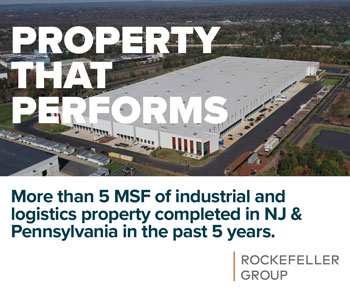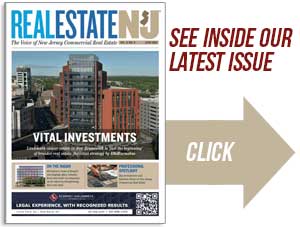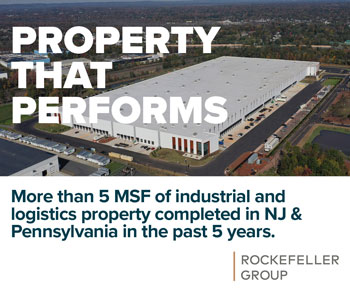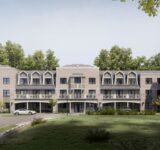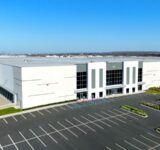A new collaboration between Dartcor and New Stand at Work, a platform that offers contactless buying, offers a variety of snacks at office buildings across the region. — Courtesy: Dartcor
By Marlaina Cockcroft
For companies hoping to get remote employees back into office buildings, Dartcor has a suggestion: Feed them well.
“I think food is a great way to get employees and tenants excited about returning to the office,” said Jason Leeds, vice president for business development at Dartcor.

His opinion should come as no surprise. Founded in 1985, the Whippany-based company offers high-end cafeteria menus, grab-and-go markets, pantries and coffee options for office buildings in New Jersey, Connecticut, Pennsylvania and New York. And, with a return to work on the horizon for many businesses, its services could be as important as ever.
Leeds said landlords and employers have been asking Dartcor how to convince employees to return as the pandemic recedes. “And they’re really leaning on us to do that with food.” He’s seen employers who might not previously have offered subsidized or free food or coffee “take their programs to a different level in order to add some excitement to the return to the office.”
Workers may still have mixed feelings about being on site. The national Littler Annual Employer Survey in May found that 71 percent of employers surveyed think employees prefer hybrid work, and 55 percent of those employers will offer a hybrid model; 28 percent of those employers, though, plan to bring back most employees full-time and in-person.
Leeds thinks “working from home for a time became very cozy and comfortable,” especially when the outside world didn’t feel safe, and expects friction in getting employees back to offices. One way to overcome that, he said, is hospitality: “How can we make people feel warm and welcome?” Dartcor provides “gift bags” of hand sanitizer, masks and food items for employees’ desks and throws “welcome back day” barbecues for clients.
“There are things that happen by chance when people run into each other and share meals together,” Leeds said, and “having your teams back in the offices, sharing meals with one another, grabbing a coffee together, just leads to a more productive culture” and a better exchange of ideas.
Dartcor, founded by Jason’s father, Warren Leeds, began as a gourmet market 30-plus years ago and branched into hospitality management, eventually focusing on corporate dining. Employers are “basically looking at food as a benefit now and a way to attract and retain best-in-class human capital,” Jason Leeds said.
In New Jersey, Dartcor uses locally sourced ingredients from AeroFarms in Newark, Ralston Farm in Hopewell and the Bread Gal Bakery in Paterson, among other vendors. The food is prepared by chefs formerly of high-end New York restaurants like Jean-Georges, Daniel and Per Se, who prefer the more family-friendly lifestyle of corporate dining, Leeds said. He thinks clients choose Dartcor because “we prioritize getting fresh, local food, putting together super-healthy menus.”
Employers and landlords generally subsidize the food to some extent — charging employees or tenants $7.50 instead of $10 for a sandwich, for instance — but have increased subsidies to entice people back, Leeds said.
The subsidies can have a nutritional impact as well. Dartcor partnered with client Crum & Forster Insurance in Morristown as it redesigned its cafeteria space, “and also worked directly with the Cleveland Clinic to create a health and wellness program.” Dartcor recommended offering a greater subsidy on salad bar items to encourage healthier eating.
“We saw tremendous results from that,” with more than 50 percent of daily purchases from employees in the healthier item category, Leeds said.
Other Dartcor clients include Teva Pharmaceuticals in Parsippany and Lowenstein Sandler LLP in Roseland.
Dartcor has expanded its offerings from on-site cafeterias to micro-markets and pantry services, as well as a “cloud market” program for buildings without on-site food service equipment. Employees order from local restaurants for a set delivery time and Dartcor delivers all meals at once. This reduces the number of delivery workers entering the building and costs less than what larger delivery platforms like DoorDash or Uber Eats charge, according to Leeds.
The company has also incorporated technology to make sure its staff wasn’t at risk during the pandemic, like enabling tenants and employees to order meals from their phones and get them at a safe pickup point. Additionally, Leeds said Hackensack Meridian Health helped Dartcor create safe procedures and cleaning protocols.

Programs such as Dartcor’s are an important component in repopulating offices, said Daniel Reider, a Rutherford-based broker and managing director with Newmark. He noted that Dartcor is “really known as the high-end food provider for commercial cafeterias and office buildings.” Food options are “part of the much bigger picture, though, about amenities and really finding the best environment for tenants … to attract and retain talent and employees.”
Most Class A buildings have a food service, cafeteria, fitness center and some sort of shared conferencing space, but some buildings are adding more amenities, Reider said, pointing to a landlord client at One Tower Center in East Brunswick.
“We’re taking an entire floor, the 15th floor of that building, and turning that just into amenity space,” with a fitness center, a golf simulator, a lounge, ping-pong and foosball tables, a small movie theater and conferencing space, he said.
Reider, whose team works with 25 buildings, said every tenant is handling the return of employees a little differently. Many tenants are leaving the choice up to employees.
“There’s definitely an excitement when there’s a new building or new amenities or enhanced workplace, that gets tenants to want to come back,” he said.
So far, people are returning to offices on a hybrid schedule.
“But every building and every company is different. You can drive by some buildings and the parking lots are already back to pre-COVID numbers, and you can drive by some and they’re still at 15, 20 percent occupancy,” Reider said.
He’s seen more momentum in client buildings over the past couple months, both people returning to the workplace and new tenants coming to look at buildings.
“Historically, the summer is a fairly quiet period of time for office leasing, but I think this summer is going to be incredibly busy as tenants are feeling more comfortable with their long-term workplace vision,” Reider said.



